by Baxter and Nina
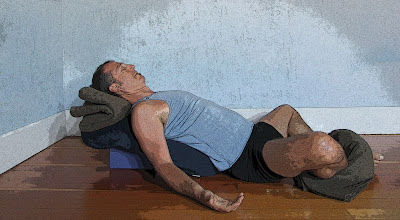
One of our favorite restorative poses, the supported version of Reclined Cobbler’s pose is a deeply relaxing pose for both body and mind. Because your head is higher than your heart in this pose, for most of you, the pose allows you to relax without falling asleep, thereby reaping the benefits of conscious relaxation (see Conscious Relaxation vs. Sleep for information about the benefits). The rest and relaxation the pose provides restores your energy as it rejuvenates your mind.
Reclined Cobbler’s pose an excellent alternative to seated meditation, as you can do pranayama or any mediation practice while reclining. Because the pose is so comfortable, your mind is free to concentrate on a particular mental focus, such as your breath or any object of meditation. As your body relaxes, your mind quiets.
Reclined Cobbler’s pose is a gentle, supported backbend, which doesn’t require muscular effort. So it’s a perfect antidote for people who spend hours in forward bending positions, including cyclists as well as desk-bound people. Because backbends are typically uplifting, the supported backbend can even promote positive mood states.
Having your arms are out to the sides broadens your chest, bringing openness to your pectoral muscles. The leg position stretches and lengthens your hip and leg muscles, especially the inner surfaces of your thighs, so the pose is beneficial for people who have tight hips or inner thighs, and helps prepare you for seated postures.
With correct propping Reclined Cobbler’s pose is accessible to most people, so almost everyone can do it. And it is so gentle that it makes a great transition into regular practice from illness or injury
Baxter prescribes this pose for:
- digestive problems
- tight hips
- tight spine
- stress in general
- fatigue
- convalescence from illness
- insomnia
- cooling after overheating
- menstrual and PMS practices
Instructions: Start by assembling your props. You will need two blankets, a bolster, and a block, as shown below. Roll one of the blankets into a long, thin roll. Fold the second blanket into a square and set it aside. And place the block under the bolster so the bolster is at an angle. If you don’t have a block to put under the bolster, you can use a thick book, a piece of wood, or whatever. If you don’t have a bolster, you can make a thick roll of two blankets or perhaps use a couch cushion. Be creative!
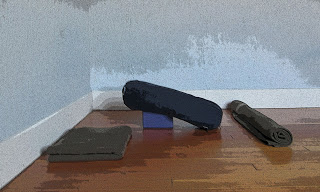
After you have set up your props as shown above, sit down in front of your bolster (but not on it!). Now bring the bottoms of your feet together into Cobbler’s pose, with your knees dropping out to the side.
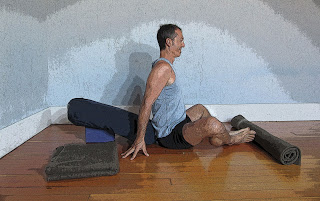
Next, take the rolled blanket and place it on top of your feet and then pull the ends around and underneath your ankles. Check to make sure your legs can rest comfortably on the blankets. If your hips are very tight, you may need additional support, such as blocks or a thicker blanket roll.
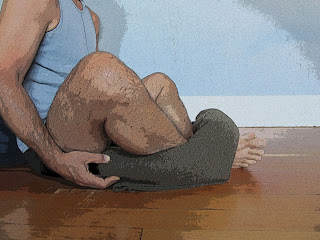
To come into the pose, place your hands on the floor by your hips and slowly lower yourself so your back is resting on the bolster. Now take your folded blanket and slip it underneath your head and neck (but not under your shoulders), making sure your head is tipped so your chin is pointing toward your chest. Rest your forearms and the backs of your hands rest on the floor out to your sides. If your elbows don’t make it down to the floor or if you arms are strained, try uses extra blankets or towels to support your arms.
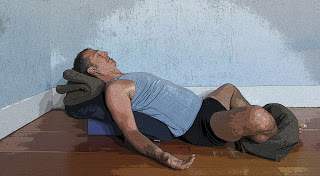
While you are in the pose, to help you quiet your mind (and trigger the Relaxation Reponse), choose a focus for your mind. You can practice breath awareness or focus on the gradual relaxation of your body, or you can practice pranayama or any form of mediation that you prefer. Stay in the pose 10 to 20 minutes, setting a timer to make sure you don’t fall asleep.
To come out of the pose, bring your hands to your outer legs to use your hands to bring your knees back together. When your feet are flat on the floor, roll slowly onto your side, rest there for a couple of breaths, and slowly come up to sitting.
Cautions: If you have active low back pain, try reducing the arch in your back in this pose by putting a folded blanket under your hips or by moving your hips forward an inch. If you have shoulder injuries, having your arms out to the side could cause pain, so add support, such as folded blankets or towels, under your arms. If you have neck stiffness or arthritis of the neck, you may need an additional blanket under your head.
If you have arthritis of the hip or a hip replacement, make sure that dropping your knees out to the sides is not painful. Try adding more support under your legs (blocks or a thicker blanket roll), but if you can’t get comfortable, come out of the pose. The combination of a backbend with your legs out the side in this pose can compress your sacroiliac joints. Adding more support under your legs might help, but you may want to avoid this pose if you are currently having SI problems.
Keep in mind that this pose is not for everyone. So if it doesn’t work for you, try some other restorative poses instead, either those that we’ll be presenting in the coming weeks or ones your teacher recommends.
Follow Yoga for Healthy Aging on Facebook ° To order Yoga for Healthy Aging: A Guide to Lifelong Well-Being, go to Amazon, Shambhala, Indie Bound or your local bookstore.


Leave A Comment